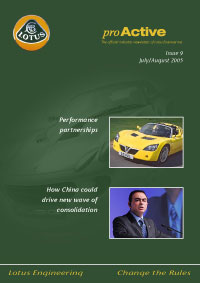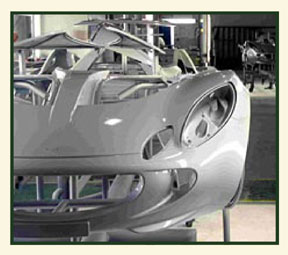ProActive Magazine from Lotus Cars
proActive is the official industry newsleter of Lotus Engineering. This is issue 97, July / August 2005

Features
Automotive partnerships - Fact or fiction?
How China could drive new wave of consolidation
Body and paint operations
Performance partnerships
News
France: Mitsuishi Motors and PSA Peugeot Citroen sign agreement for SUV joint venture
Germany: Knorr-Bremse launches joint venture with Tata Autocomp Systems
India: Bosch forms filter joint venture with Mann and Hummel
UK: Ford soon to introduce bioethanol cars to UK
Body and paint operations
When you walk up to a new car the first thing that should catch your eye is the sun gleaming off of the perfectly polished paintwork. However, no matter how well designed or built it is, a poor finish will create a negative impression before the customer has even sat in the driverâs seat.
Here at Lotus not only did we need to source a high quality paint to finish our product, but also one that was waterbased with low temperature curing properties. We worked closely with Dupont to validate their new water based paint system here at Lotus during the late 90âs, and have continued over the years to innovate and try new ideas within this partnership.
Over the past two years we have made great improvements to staff training, the process, materials, and facilities, which have meant real gains for the full spectrum of the Key Performance Indicators (KPIs). How well we have reached our objectives will primarily be judged by technical testing performed by both Lotus and Dupont, our preferred paint supplier, feedback from any warranty claims, and of course customer satisfaction.

To run our successful manufacturing department here at Lotus we need the â4 Mâsâ: Man, Machine, Materials and Method. When all the â4 Mâsâ come together in harmony to create the perfectly finished car, it is called a âGun Finishâ by our Paint and Body department. This means âa painted car set that has had no paint rectification carried out other than a de-nib of dirtâ, or minor repair area that causes minimal damage to the clear coating. Reaching this level of perfection takes a number of stages.
Stage 1: Knowing your tools.
To maximise the usage of materials we must first fully understand them. The clear acrylic layer that sits on top of the colour coat and acts as a shield (see Figure 1) is the hardest and toughest part. Once applied, the topcoat will take up to two weeks to cure, meaning any polish rework cannot be carried out too early because it could require more work in the future before it leaves the factory. Additional polishing will also be required to remove any marks after build and part cure has occurred.

Fig 1: Illustration of the paint system
Stage 2: Changing habits.
We must then address how to change the processes that have always been followed. How can we influence our staff and adapt their behaviour? To accept the need to change we have coached and retrained our team here at Lotus.
Stage 3: Gaining confidence.
By continuously feeding back the advantages of our new systems through quality data within the manufacturing division, paint supplier audits and customer feedback, we have gained confidence. This has in turn led to further enhancements to the evolving concept.
Stage 4: Making the grade.
Gun Finishâ to us now means that all of the car are polished within the main paint facility. Faults in the paint are then graded to determine whether they can be reworked at a later stage without the need for further paint application, known as a blow in, or investigated further by the operator. One of our operators can then use abrasive materials to investigate the fault before giving the car its final polish.
Should a fault be too severe for a minor rework, the part will be rejected and passed back for reworking before returning to our production line.
A key advance that has assisted the evolution of the process was the introduction of a âHigh Build Primerâ. Developed in conjunction with Dupont, this product has enabled vehicles to be primed in a single pass. It also has the ability to hide minor panel defects reducing the amount of rework necessary.
Stage 5: The future.
The focus for the future will centre on: Investigating methods to cure the paint system in a more efficient manner to reduce stress on both the substrate panel and the system itself. Working to reduce the amount of dirt within the paint system itself, which can lead to reworking.
Testing new primer systems that will require minimum preparation work prior to colour and clear coating.
Summary
Next time you walk past a new Lotus car take the time to notice the top quality finish that has been created by our hardworking team here at Hethel.
